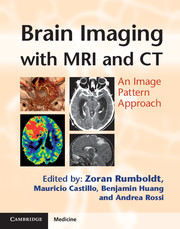Book contents
- Frontmatter
- Contents
- List of contributors
- List of abbreviations
- Preface
- Section 1 Bilateral Predominantly Symmetric Abnormalities
- Section 2 Sellar, Perisellar and Midline Lesions
- Section 3 Parenchymal Defects or Abnormal Volume
- Section 4 Abnormalities Without Significant Mass Effect
- 97 Dural Venous Sinus Thrombosis
- 98 Dural Arteriovenous Fistula
- 99 Subarachnoid Hemorrhage
- 100 Laminar Necrosis
- 101 Neurocutaneous Melanosis
- 102 Superficial Siderosis
- 103 Polymicrogyria
- 104 Seizure-Related Changes (Peri-Ictal MRI Abnormalities)
- 105 Embolic Infarcts
- 106 Focal Cortical Dysplasia
- 107 Tuberous Sclerosis Complex
- 108 Dysembroplastic Neuroepithelial Tumor (DNT, DNET)
- 109 Nonketotic Hyperglycemia With Hemichorea–Hemiballismus
- 110 Hyperdensity Following Endovascular Intervention
- 111 Early (Hyperacute) Infarct
- 112 Acute Disseminated Encephalomyelitis (ADEM)
- 113 Susac Syndrome
- 114 Diffuse Axonal Injury
- 115 Multiple Sclerosis
- 116 Progressive Multifocal Leukoencephalopathy (PML)
- 117 Nodular Heterotopia
- 118 Neurosarcoidosis
- 119 Meningeal Carcinomatosis
- 120 Meningitis (Infectious)
- 121 Perineural Tumor Spread
- 122 Moyamoya
- 123 Central Nervous System Vasculitis
- 124 Subacute Infarct
- 125 Active Multiple Sclerosis
- 126 Capillary Telangiectasia
- 127 Developmental Venous Anomaly
- 128 Immune Reconstitution Inflammatory Syndrome (IRIS)
- 129 Ventriculitis
- Section 5 Primarily Extra-Axial Focal Space-Occupying Lesions
- Section 6 Primarily Intra-Axial Masses
- Section 7 Intracranial Calcifications
- Index
- References
125 - Active Multiple Sclerosis
from Section 4 - Abnormalities Without Significant Mass Effect
Published online by Cambridge University Press: 05 August 2013
- Frontmatter
- Contents
- List of contributors
- List of abbreviations
- Preface
- Section 1 Bilateral Predominantly Symmetric Abnormalities
- Section 2 Sellar, Perisellar and Midline Lesions
- Section 3 Parenchymal Defects or Abnormal Volume
- Section 4 Abnormalities Without Significant Mass Effect
- 97 Dural Venous Sinus Thrombosis
- 98 Dural Arteriovenous Fistula
- 99 Subarachnoid Hemorrhage
- 100 Laminar Necrosis
- 101 Neurocutaneous Melanosis
- 102 Superficial Siderosis
- 103 Polymicrogyria
- 104 Seizure-Related Changes (Peri-Ictal MRI Abnormalities)
- 105 Embolic Infarcts
- 106 Focal Cortical Dysplasia
- 107 Tuberous Sclerosis Complex
- 108 Dysembroplastic Neuroepithelial Tumor (DNT, DNET)
- 109 Nonketotic Hyperglycemia With Hemichorea–Hemiballismus
- 110 Hyperdensity Following Endovascular Intervention
- 111 Early (Hyperacute) Infarct
- 112 Acute Disseminated Encephalomyelitis (ADEM)
- 113 Susac Syndrome
- 114 Diffuse Axonal Injury
- 115 Multiple Sclerosis
- 116 Progressive Multifocal Leukoencephalopathy (PML)
- 117 Nodular Heterotopia
- 118 Neurosarcoidosis
- 119 Meningeal Carcinomatosis
- 120 Meningitis (Infectious)
- 121 Perineural Tumor Spread
- 122 Moyamoya
- 123 Central Nervous System Vasculitis
- 124 Subacute Infarct
- 125 Active Multiple Sclerosis
- 126 Capillary Telangiectasia
- 127 Developmental Venous Anomaly
- 128 Immune Reconstitution Inflammatory Syndrome (IRIS)
- 129 Ventriculitis
- Section 5 Primarily Extra-Axial Focal Space-Occupying Lesions
- Section 6 Primarily Intra-Axial Masses
- Section 7 Intracranial Calcifications
- Index
- References
Summary
Specific Imaging Findings
Active multiple sclerosis (MS) plaques cause breakdown of the blood–brain barrier (BBB) and therefore enhancement on postcontrast MR images. Two enhancement patterns exist: uniform, reflecting the onset of a new lesion, and ringlike, indicating reactivation of an older lesion. Uniform enhancement may be faint, irregular, and with ill-defined margins. Peripheral ring-like enhancement is usually incomplete (“open”); however, it may form a full circle. There is no associated mass effect and no edema surrounding the enhancing area (except for tumefactive MS, which is discussed separately). Hyperacute plaques (first 24 h) may show restricted diffusion due to acute inflammation. On DWI acute lesions frequently show a ring pattern with hyperintense rim, while the center of the lesion has high ADC values. The diffusion findings and contrast enhancement, however, frequently do not coexist. Although MS plaques can be found throughout the brain, they have a predilection for periventricular white matter, corpus callosum, juxtacortical regions, optic radiations, as well as infra-tentorial locations. The enhancing lesions also follow this distribution. Ovoid appearance with orientation perpendicular to the ventricular surface is highly characteristic, but only on axial images. Microbleeds may be seen within MS plaques on T2* MR imaging, primarily with SWI. The detection rate of enhancing lesions is increased by delayed imaging, triple dose of contrast and use of magnetization transfer. The higher contrast dose may have a role in cases of diagnostic doubt following the standard dose.
Information
- Type
- Chapter
- Information
- Brain Imaging with MRI and CTAn Image Pattern Approach, pp. 257 - 258Publisher: Cambridge University PressPrint publication year: 2012
